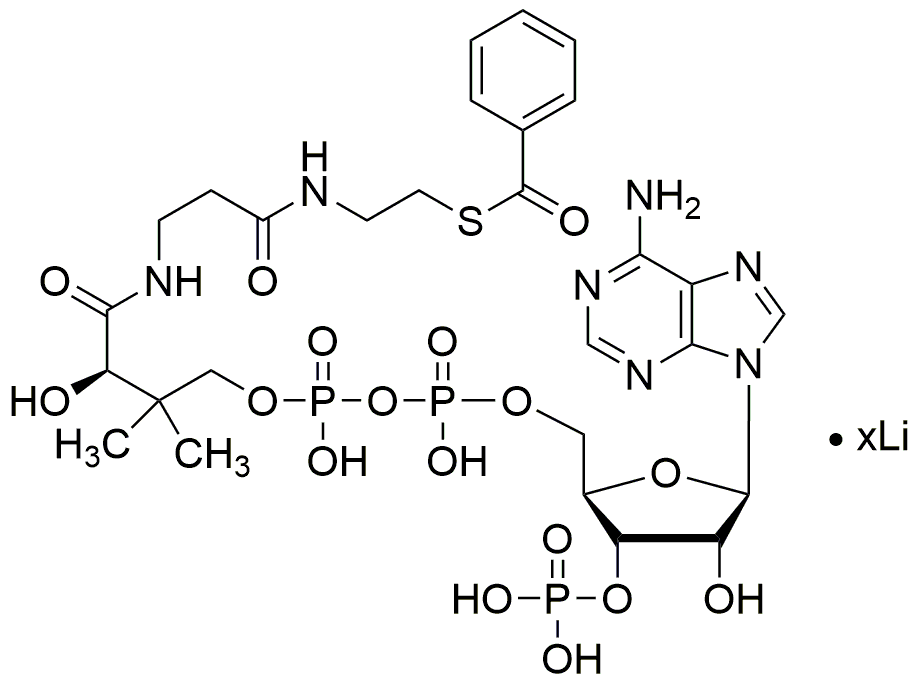Benzoyl coenzyme A lithium salt is widely utilized in research focused on:
- Biochemical Research: This compound is essential for studying metabolic pathways involving aromatic compounds, aiding researchers in understanding cellular processes and enzyme functions.
- Pharmaceutical Development: It serves as a key intermediate in synthesizing various pharmaceuticals, particularly those targeting metabolic disorders, enhancing drug efficacy and specificity.
- Food Industry Applications: Used in food chemistry, it helps in flavor enhancement and preservation, contributing to the development of healthier food products.
- Biotechnology: In genetic engineering, it plays a role in the modification of metabolic pathways, allowing for the production of biofuels and bioplastics from renewable resources.
- Analytical Chemistry: This compound is utilized in analytical methods for detecting and quantifying aromatic compounds in environmental samples, supporting regulatory compliance and safety assessments.
Informations générales
Propriétés
Sécurité et réglementation
Applications
Benzoyl coenzyme A lithium salt is widely utilized in research focused on:
- Biochemical Research: This compound is essential for studying metabolic pathways involving aromatic compounds, aiding researchers in understanding cellular processes and enzyme functions.
- Pharmaceutical Development: It serves as a key intermediate in synthesizing various pharmaceuticals, particularly those targeting metabolic disorders, enhancing drug efficacy and specificity.
- Food Industry Applications: Used in food chemistry, it helps in flavor enhancement and preservation, contributing to the development of healthier food products.
- Biotechnology: In genetic engineering, it plays a role in the modification of metabolic pathways, allowing for the production of biofuels and bioplastics from renewable resources.
- Analytical Chemistry: This compound is utilized in analytical methods for detecting and quantifying aromatic compounds in environmental samples, supporting regulatory compliance and safety assessments.
Documents
Fiches de données de sécurité (FDS)
La FDS fournit des informations de sécurité complètes sur la manipulation, le stockage et l’élimination du produit.
Spécifications du produit (PS)
Le PS fournit une description complète des propriétés du produit, notamment sa composition chimique, son état physique, sa pureté et les exigences de stockage. Il détaille également les plages de qualité acceptables et les applications prévues du produit.
Certificats d'analyse (COA)
Recherchez des certificats d'analyse (COA) en saisissant le numéro de lot du produit. Les numéros de lot et de lot se trouvent sur l'étiquette d'un produit, après les mots « Lot » ou « Lot de fabrication ».
Numéro de catalogue
Numéro de lot/série
Certificats d'origine (COO)
Ce certificat d'exploitation confirme le pays dans lequel le produit a été fabriqué, et détaille également les matériaux et composants utilisés et s'il est issu de sources naturelles, synthétiques ou autres sources spécifiques. Ce certificat peut être requis pour les douanes, le commerce et la conformité réglementaire.
Numéro de catalogue
Numéro de lot/série
Fiches de données de sécurité (FDS)
La FDS fournit des informations de sécurité complètes sur la manipulation, le stockage et l’élimination du produit.
DownloadSpécifications du produit (PS)
Le PS fournit une description complète des propriétés du produit, notamment sa composition chimique, son état physique, sa pureté et les exigences de stockage. Il détaille également les plages de qualité acceptables et les applications prévues du produit.
DownloadCertificats d'analyse (COA)
Recherchez des certificats d'analyse (COA) en saisissant le numéro de lot du produit. Les numéros de lot et de lot se trouvent sur l'étiquette d'un produit, après les mots « Lot » ou « Lot de fabrication ».
Numéro de catalogue
Numéro de lot/série
Certificats d'origine (COO)
Ce certificat d'exploitation confirme le pays dans lequel le produit a été fabriqué, et détaille également les matériaux et composants utilisés et s'il est issu de sources naturelles, synthétiques ou autres sources spécifiques. Ce certificat peut être requis pour les douanes, le commerce et la conformité réglementaire.


